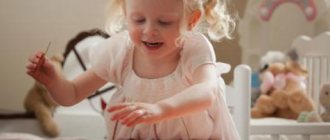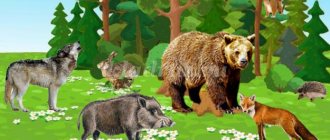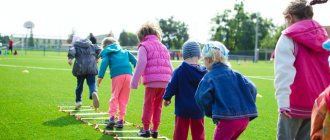Educational areas: “Cognition”, “Speech development”, “Artistic creativity”, “Socialization”, “Music”, “Physical development”.
Purpose: to introduce the names of domestic animals and their babies.
Objectives: Educational objectives. enrich children's ideas about pets, caring for them, the benefits of animals, teach comparison, teach children to form complex words, plural nouns, practice finding geometric shapes, convey the characteristic features of an animal in a drawing. Developmental tasks. develop speech, thinking, memory, attention, perception; develop fine and gross motor skills; develop creativity; develop aesthetic perception; replenish vocabulary on the topic, develop inflection and word formation; Educational tasks. to cultivate in children a cognitive interest in the world around them, to cultivate independence in completing tasks.
Materials and equipment: pictures with images of domestic animals and their cubs, figurines of domestic animals, sheets of paper, paints, brushes.
Preliminary work: reading the poem “Confusion” by K. Chukovsky. Looking at pictures of domestic animals and their babies, watching a dog or cat on the street. Riddles about animals. Conversations about animals.
Progress.
Educator: - Guys, let's try to guess what we will talk about today and what we will do.
Puzzles
Instead of a tail - a hook, Instead of a nose - a snout. The snout is full of holes, and the hook is fidgety. (Piglet) A fur coat and a caftan walks across the mountains and valleys (Sheep)
I know how to wash myself cleanly, not with water, but with my tongue. Meow! How often I dream about a saucer with warm milk! (Cat)
She has horns and hooves, And she looks angrily at everyone, But she is kinder than a puppy, And she will pour us milk. (Cow)
I must protect the house. I'll sniff everything around. I will throw myself into the river to save you, I am man’s first friend. I bark if there is a fight somewhere, Because I am... (Dog)
Educator: - Well done, guys! Now let's compare wild and domestic animals with you. Why do you think the fox, bear, wolf, hedgehog are called wild animals? Children: - They live in the forest, get food themselves, build houses, take care of the cubs. Educator: - What are these animals called? (Shows pictures of a dog, cat, cow, goat, horse, sheep, pig) Children: - Pets. Educator: - Why are they called that? Children: – These animals live next to humans; people take care of them, feed them, build homes for them. Educator: - Who is shown in these pictures? (Shows pictures of a kitten, puppy, foal, piglet, kid, calf). Children: - Young domestic animals. The teacher shows the pictures one at a time and asks them to name what is depicted on them, and then for the pictures “Cubs” the children select the picture “Adult Animals” and name the corresponding chain:
cat-cat-kitten dog-dog-puppy horse-horse-foal cow-bull-calf pig-boar-piglet goat-goat-kid
Educator: - Okay, guys, now let's play a game with you.
Word game “Who lives where?”
Educator: - Guys, all domestic animals live next to humans. And each animal has its own separate place where it lives. Who knows the names of these places? Children: - A pig lives in a pigsty, cows - in a barn, sheep - in a sheepfold, a cat - in a house, dogs - in a kennel, horses - in a stable. Then the teacher names the animal, and the children say where it lives. Educator: - Guys, what is it called when a lot of cows, goats, horses, sheep, dogs get together? Children: - Herd, herd, flock, flock. Educator: - Guys, let's continue the phrases: a herd is a lot...... a herd is a lot...... a flock is a lot.... a flock is a lot... Educator: - Guys, let's think about what benefits do pets bring? Children: - Dog - guards the house; cat - catches mice; the cow gives milk and meat; horse – transports people and goods; goat - gives milk, meat, wool; sheep - gives meat; wool, pig - meat. Educator: - Children, let us describe the cow according to plan: size, color, how it “talks”, characteristic features of body parts, where it lives, what it eats, what benefits it brings. Children: - A cow is a large animal. It comes in brown, white and black. She says “Moo-moo”, she hums. The cow has long legs and a tail. She has horns. She lives in a barn, eats grass and hay. The cow gives milk and meat. Game one - many Educator: - Guys, now I will name the animal for you, and you will call it in the plural: cow - cows horse - horses dog - dogs cat - cats goat - goats sheep - sheep And now guys, everyone get out -at the table, you and I will warm up a little.
Physical education minute
They run, run from the yard (we walk in place) Walk, walk in the meadows: (jumping on the spot) Trigger-garaburka-whatever, (clap our hands) Duck-floater-clank-quack, (stomp our feet) Goose-water- eider-wagi, (crouch) Turkey-khripindyuk-shulty-buldy, (clap our hands) Pig-fat-backed-chahi-ryakhi, (stomp our feet) Goat-deribosa-fur-beke, (crouch) Ram-krutorogan-chiki-bryki , (clap our hands) Cow-komol-tpruki-torment, (stomp our feet) Horse-kick-igi-vigi. (we walk in place)
Educator: - Guys, well done, and now we will draw a cat. We will paint it with paints. Children, look at the picture, what do you think the cat’s body, head, paws, ears look like? Children: - The body looks like an oval, the head - like a ball, paws - like sticks, columns, ears - like triangles. Educator: - Let's see where we draw the head in relation to the body, where are the tail and paws? Children: - Head from above and from the edge of the body. Ears on the head. The tail is at the back, the paws are at the bottom of the body. Educator: - Guys, count how many paws a cat has? Should they be the same size or does it not matter? And why do we draw the paws from below relative to the body? Children: - There must be four paws, they must be below the body and of the same size so that the animal can stand on them steadily and not fall. Educator: - Well done guys! Let's remember what we did today? What did you like most?
Literature:
“Complex classes” according to the program “From birth to school”, ed. NOT. Veraksy, T.S. Komarova, M.A. Vasilyeva.
Progress of the lesson.
Educator: Children, do you like to travel? (Children's answers)
Today we will take a train trip to the village.
On the way we will pass through the forest. Who can tell me who we can meet in the forest? (Fox, wolf, bear, deer, hedgehog, hare)
.
What are the names of all these animals ? (Wild)
.
Educator: That's right, Timur, these animals are called wild . Do you think we can meet these animals in the village? (No)
.
Educator: Why can’t we meet them?
Children: Because they are wild animals and live in the forest .
Educator: That's right, then who will we meet in the village?
Children: Cow, horse, sheep, pig, chicken, cat, dog, duck.
Educator: That's right, well done. Animals that live in the forest are called wild, and those that live in the village are called wild. ( Homemade )
. Why are they called that?
Children: Because they live next to people, and people take care of them and their offspring.
Educator: That's right, well done. I suggest you play the game “What’s missing?”
The teacher hangs several pictures of animals . Then the children close their eyes. One picture is removed. Children open their eyes and say which picture is missing.
“Where do they live? The teacher’s story about where pets
Educator: Do you know that these animals can be in large and small quantities. If there are many horses, it is called a herd; if there are many pigs, it is called a herd; if there are many cows, it is called a herd.
A herd is a lot...; a herd is a lot...; a flock is a lot...; a flock is a lot...
Physical education minute “Khomka”
Hammer, Hammer, Hamster, (circular movements on the stomach )
Striped barrel. (straight movements on the sides)
Khomka gets up early, (stretch)
Washes the neck (imitation of washing the neck)
Rubs cheeks. (rub cheeks with fists)
Khomka cleans the hut (imitation sweeping)
And goes out to exercise: (walk in place)
One, two, three, four, five (arms forward, up, forward, to the sides, down)
Khomka wants to become strong. (show how strong Khoma is)
Teacher's story about the benefits of animals .
-What animal guards the house (dog)
-Who catches mice? (cat)
-What animals give milk (goat, cow)
-Which animal wool is used to make clothing (goat, sheep, rabbit)
Educator: Well done, you know a lot about pets . And now we will try to describe the cow.
Children, together with the teacher, describe the cow according to the plan: what size is it; what color it is; characteristic features of body parts; where he lives; what does it eat; what benefits does it bring to people?
A cow is a large animal . It comes in black, white, brown. The cow has long legs, a tail, and a mane. She lives in a barn, eats grass, hay, gives milk and meat.
Summary of the lesson .
-Did you like our trip?
-What were we talking about?
-What will you tell your parents about?
-What did you like most?
Summary of an integrated lesson on cognitive development in the senior group “Pets” Summary of an integrated lesson on cognitive development in the senior group on the topic “Pets” Objectives: Expand and consolidate.
Summary of educational activities on speech development in the middle group topic: “Wild and domestic animals” Purpose: To summarize children’s knowledge on the topic. Educational objectives: To consolidate ideas about domestic and wild animals; Clarify, expand, etc.
Notes on speech development in the middle group “Domestic and wild animals” Goals: Expanding vocabulary and consolidating knowledge about domestic and wild animals in preschool children. Program content:.
Notes in the second early age group on cognitive development “Pets” Notes in the second early age group on cognitive development on the topic “Pets” Purpose: To consolidate children’s knowledge about pets. Summary of a lesson on cognitive development for children of the junior group “Pets and their cubs” Summary of a lesson on cognitive development for children of the junior group “Pets and their cubs” If you meet a cow, do not be afraid.
Summary of a lesson on cognitive development in the middle group “Wild animals in winter” Purpose: To create conditions for the formation of ideas about how wild animals adapt to changing weather conditions. Tasks:.
"Pets". Summary of a lesson on speech development for the middle group “Sounds of the surrounding reality” Objectives: • To learn to distinguish the sounds of the surrounding reality “Pets”; • Development of auditory attention, memory; • Development of speech on.
GCD on cognitive development in the middle group “Pets. Journey to a village farmstead" Implementation of the program content in educational areas: "Cognitive development", "Artistic and aesthetic development", "Speech development".
"Pets". Notes on cognitive development in the second junior group. Notes on cognitive development in the second junior group on the topic: “Grandma Matryona and her pets.” Prepared and conducted.
Organized educational activities on cognitive development for the middle group “Pets” Objectives: 1. Develop memory, logical thinking, voluntary attention, activate children’s vocabulary. 2. Reinforce previously studied material.
Source
"Pets". Cognitive lesson in the middle group
Galina Romanova
"Pets". Cognitive lesson in the middle group
1. To form an idea about pets , their appearance and lifestyle.
2. Form a general concept of “ pets ”
.
3. Learn to solve riddles.
4. Provide knowledge about the benefits of pets for humans .
5. Develop thinking, attention, speech.
6. Foster a caring attitude towards pets .
Benefits:Paintings: “Pig Farm”
,
“Stable”
,
“Cow in the barn”
,
“Goat in the barn”
,
“Rabbits in the cage”
;
poems, riddles, “Puzzles” (
pets ) .






